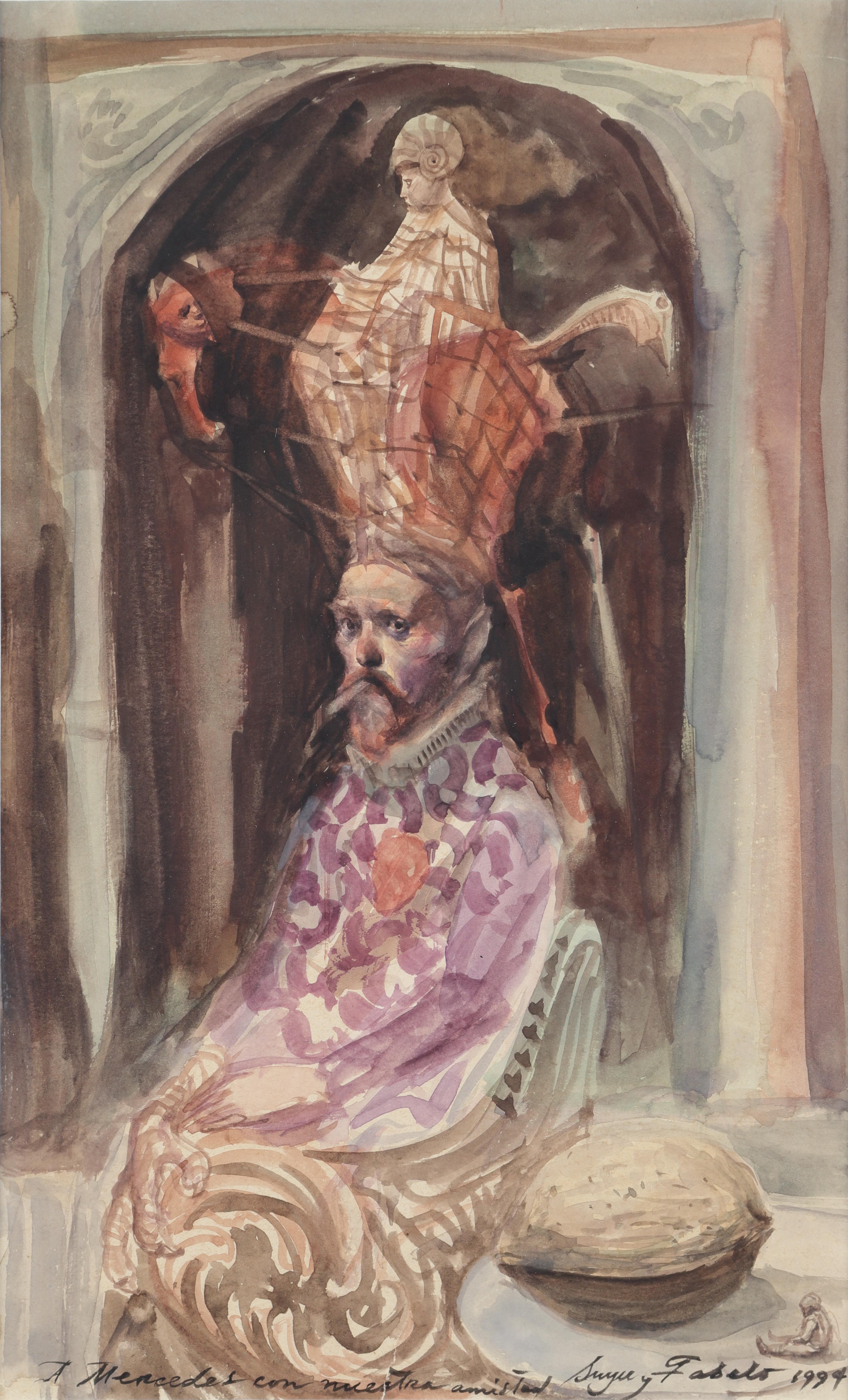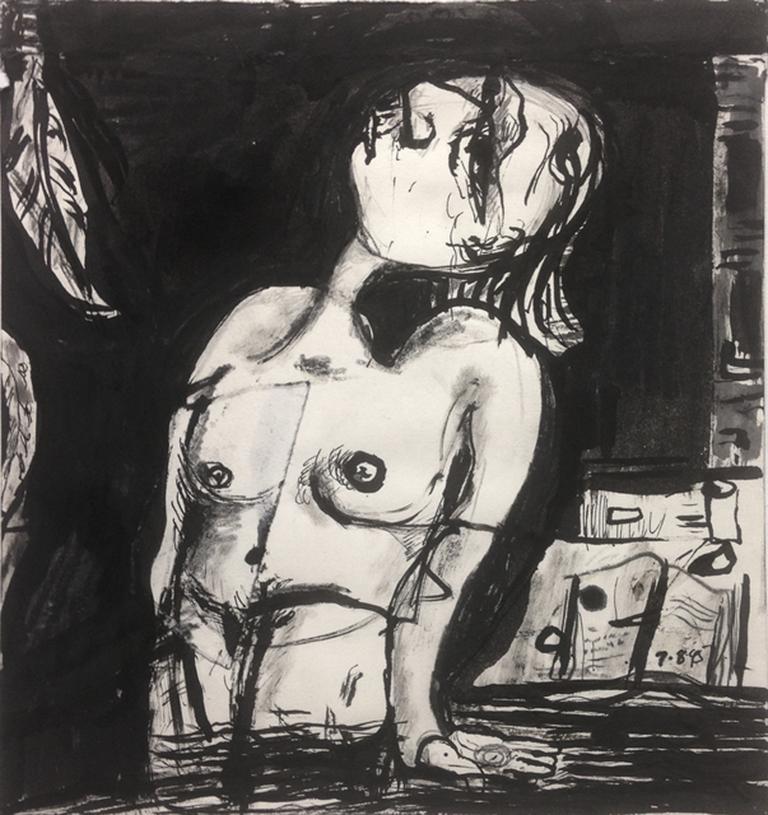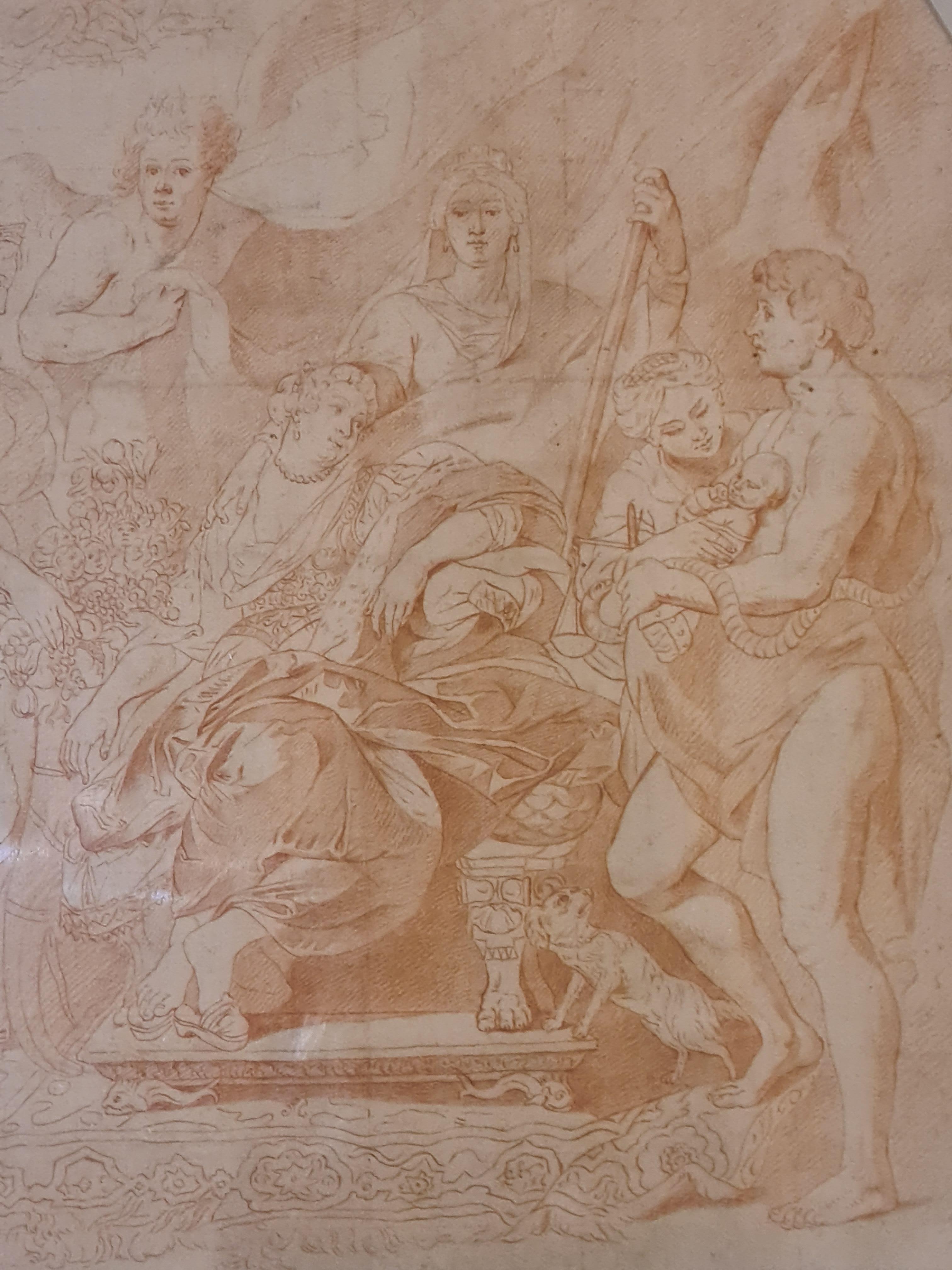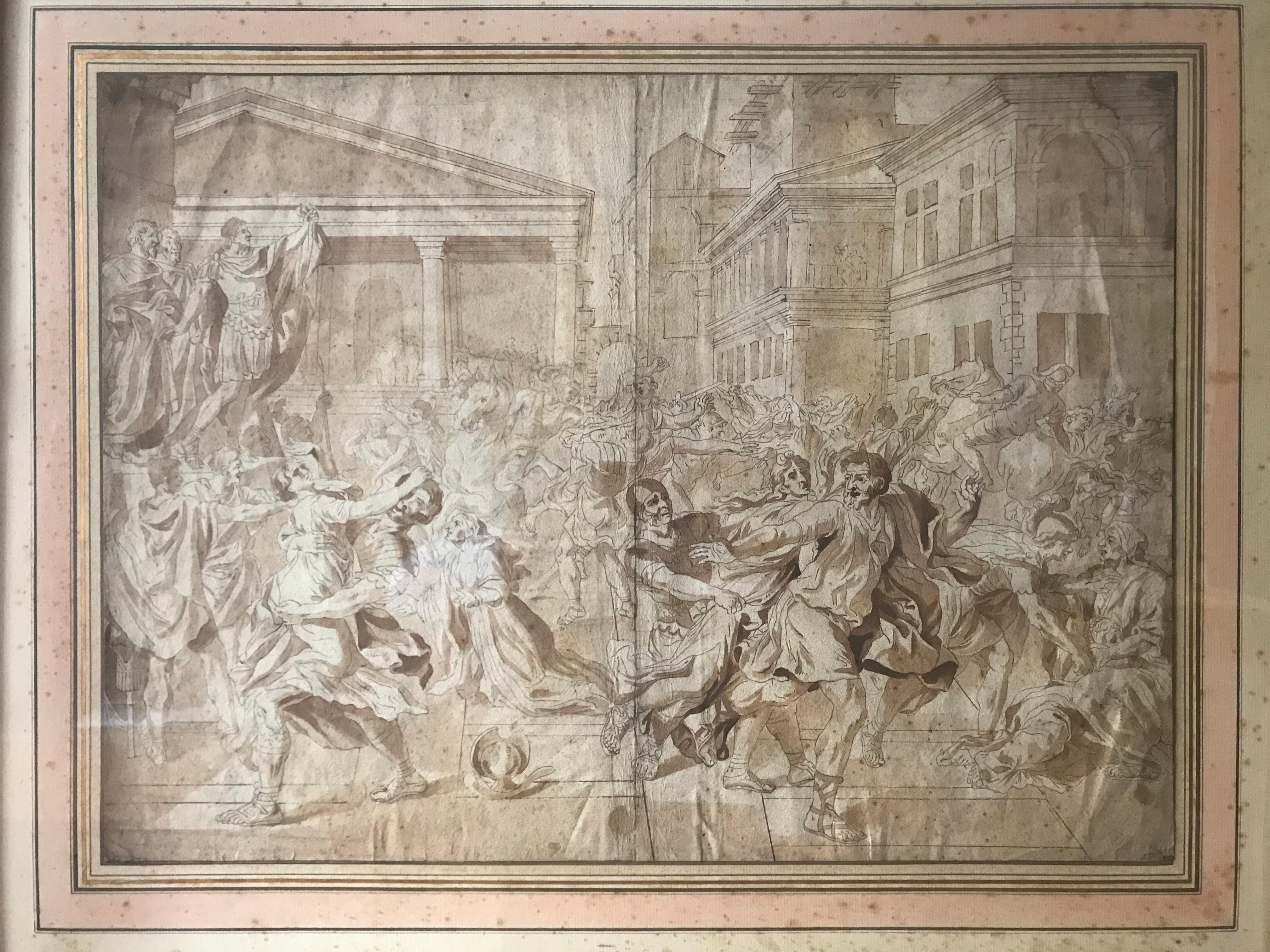Items Similar to Two Angels - Ink and Watercolor Drawing by A. Brustolon - Early 1700
Want more images or videos?
Request additional images or videos from the seller
1 of 3
Andrea BrustolonTwo Angels - Ink and Watercolor Drawing by A. Brustolon - Early 1700Early 1700
Early 1700
About the Item
Due Angeli is an original artwork realized by Andrea Brustolon.
Mixed media, ink and watercolor.
The artwork rapresents two baroque angels, study realized by Brostolon for a sculpture.
Very good conditions. Signed on the lower side of the drawing by the artist. On the lower side of the plate a short description of the drawing. Including a cardboard cm 49x34
Andrea Brustolon (1662-1732) was an Italian wood-carver, born in Belluno. he was known for his furniture in the Venetian Baroque style, characterized by extravagant curves and lavish ornamentation. He was called "Michelangelo del legno" (Michelangelo of the wood).
- Creator:Andrea Brustolon (1662 - 1732)
- Creation Year:Early 1700
- Dimensions:Height: 5.36 in (13.6 cm)Width: 9.3 in (23.6 cm)Depth: 0.08 in (2 mm)
- Medium:
- Movement & Style:
- Period:
- Framing:Framing Options Available
- Condition:Insurance may be requested by customers as additional service, contact us for more information.
- Gallery Location:Roma, IT
- Reference Number:
About the Seller
4.9
Platinum Seller
These expertly vetted sellers are 1stDibs' most experienced sellers and are rated highest by our customers.
1stDibs seller since 2017
6,749 sales on 1stDibs
Typical response time: 2 hours
- ShippingRetrieving quote...Ships From: Rome, Italy
- Return PolicyA return for this item may be initiated within 14 days of delivery.
More From This SellerView All
- Réveil du Cineaste - Original Drawing by Bernard Bécan - Mid-20th CenturyBy Bernard BécanLocated in Roma, ITRéveil du Cineaste is an Original China Ink and Watercolor Drawing realized by Bernard Becan in the Mid-20 Century. The little artwork is in good condition except for being aged. T...Category
Mid-20th Century Modern Figurative Drawings and Watercolors
MaterialsInk, Watercolor
- Les Jambes China - Original Drawing by Bernard Bécan - Mid-20th CenturyBy Bernard BécanLocated in Roma, ITLes Jambes China is an Original Ink and Watercolor Drawing realized by Bernard Becan in the Mid-20 Century. The little artwork is in good condition except for being aged. The artwo...Category
Mid-20th Century Modern Figurative Drawings and Watercolors
MaterialsWatercolor, Ink
- Laboratory - Original Drawing by Bernard Bécan - Mid-20th CenturyBy Bernard BécanLocated in Roma, ITLaboratory is an Original China Ink and Watercolor Drawing realized by Bernard Becan in the Mid-20 Century. The little artwork is in good condition exce...Category
Mid-20th Century Modern Figurative Drawings and Watercolors
MaterialsWatercolor, Ink
- Profiles - Original Ink and watercolor by Eugène Giraud - Late 19th CenturyBy Eugène GiraudLocated in Roma, ITProfiles is an Original Drawing in Ink and watercolor realized by Eugène Giraud in the Late 19th Century. Good conditions. The delicate and beautiful fine strokes form the artwork....Category
Late 19th Century Modern Figurative Drawings and Watercolors
MaterialsWatercolor, Ink
- Landscape - Original Drawing by Paulette Humbert - 1940By Paulette HumbertLocated in Roma, ITLandscape is an Original drawing in Pen and China Ink realized in 1940 by Paulette Humbert. Good conditions. The artwork is depicted through soft strokes in a well-balanced composi...Category
1940s Modern Figurative Drawings and Watercolors
MaterialsWatercolor, Ink
- Landscape - Original Drawing by Paulette Humbert - Mid-20th CenturyBy Paulette HumbertLocated in Roma, ITLandscape is an Original drawing in ink and watercolor realized in the mid-20th Century by Paulette Humbert. Good conditions. The artwork is depicted through soft strokes in a well...Category
Mid-20th Century Modern Figurative Drawings and Watercolors
MaterialsWatercolor, Ink
You May Also Like
- UntitledLocated in Miami, FLRoberto Fabelo (born in 1951 in Camagüey, Cuba) is a contemporary painter, sculptor, and illustrator. Born in Guáimaro, Camagüey, Fabelo studied at The National Art School and the Superior Art Institute of Havana. He was a professor and a jury member for important national and international visual arts contests. The Cuban state awarded him a medal for National Culture and the Alejo Carpentier medal for his outstanding artistic career. Fabelo’s art consists of nude women, who often appear with bird-like features, including a beak and wings. He drew in textbooks and created figures from the pictures in the book. Another example of his art was watercolor markers used to draw on silk embroidered fabric. His work is exhibited at the Museo Nacional de Bellas Artes in Havana and the Cuban embassy in Mexico. His 2009 sculpture of a group of human-headed cockroaches can be found climbing one of the walls of the Havana Fine Arts Museum, entitled Survival. He also illustrated a 2007 edition of Gabriel García Márquez’s novel Cien años de soledad. He was described by the Dallas Morning News in 2002 as “one of Cuba’s premier artists...Category
1990s Baroque Figurative Drawings and Watercolors
MaterialsPaper, Watercolor
- Capriccio Landscape View with FiguresLocated in Houston, TXCapriccio painting in a greek or Italian style with women around a river. Capriccio is a fanciful architectural landscape painting. It was popular in Italy in the 18th Century. Most ...Category
Late 19th Century Baroque Landscape Drawings and Watercolors
MaterialsGouache
- Orpheus and the Animals, A Study after an Ancient Bas-ReliefLocated in New York, NYInscribed “55” and “218” in the lower right Watermark: Heawood 1351 Laid down on historic Cassiano Del Pozzo mount (Mount Type A, 531 x 402 mm) Provenance: Commissioned by Cassiano dal Pozzo (1588–1637) for his Museo Cartaceo (Paper Museum) and kept in the library of his palazzo, via dei Chiavari, Rome Transferred with the entire dal Pozzo collection by fidecommesso to his younger brother, Carlo Antonio dal Pozzo (1606–1689); by descent to his second son: Gabriele dal Pozzo (d. 1695); by descent to his wife: Anna Teresa Benzoni and after her remarriage in 1697, the Marchesa Lancellotti de’ Ginnetti (d. 1736); by descent to their son: Cosimo Antonio dal Pozzo (d. 1740); by whom sold with the Dal Pozzo library in 1703 to: Pope Clement XI for the Vatican Library; by whom transferred as part of the Museo Cartaceo in January 1714 to his nephew: Cardinal Alessandro Albani (1692–1779), Palazzo ‘alle Quattro Fontane’ in Rome; by whom sold in 1762 to: James Adam, agent for the British Royal Librarian Richard Dalton (1715–1791) King George III of England, Buckingham House Among the sheets of the ‘Museo Cartaceo’ appropriated by Richard Dalton during a reorganization of the drawings, circa 1786-1788; his estate sale, Greenwood’s, London, 11-19 May 1791; where acquired by: John MacGowan...Category
16th Century Baroque Figurative Drawings and Watercolors
MaterialsPaper, Ink, Pen
- "Wading Woman", drawing, ink, portraitLocated in Toronto, OntarioInk, litho crayon & collage on paperCategory
21st Century and Contemporary Mannerist Figurative Drawings and Watercolors
MaterialsInk, Paper, Crayon
- 18th Century Sanguine Drawing, La Naissance de Louis XIII, After Rubens.Located in Cotignac, FR18th Century French Sanguine drawing, possibly a preparatory sketch for the painting by Nattier after the painting by Rubens. Presented in shaped 'marie-louise' mount in plain gold wood frame with collection label. The subject is the Queen Marie de' Medici seated on a grand throne, the baby is in the arms of Health while Justice looks over him. Fecundity brings a cornucopia of fruit with the heads of the other children the Queen will bear. The Sun rides his chariot across the sky to indicate that Louis XIII was born in the morning and the calm figure of France surveys the whole scene. An engraving exists (see the Wellcome Collection) of this same image: 'The birth of King Louis XIII', after the engraving by B. Audran the younger after the painting by Jean-Marc Nattier after the oil painting of Peter Paul Rubens in the Louvre 'La Naissance du Dauphin (future Louis XIII) à Fontainebleau, le 27 septembre 1601'. Jean-Marc Nattier (17 March 1685 – 7 November 1766) was a French painter. He was born in Paris, the second son of Marc Nattier (1642–1705), a portrait painter, and of Marie Courtois (1655–1703), a miniaturist. He is noted for his portraits of the ladies of King Louis XV's court in classical mythological attire. He received his first instruction from his father, and from his uncle, the history painter Jean Jouvenet (1644–1717). He enrolled in the Royal Academy in 1703 and applied himself to copying pictures in the Luxembourg Palace, making a series of drawings of the Marie de Médici painting...Category
18th Century Baroque Figurative Drawings and Watercolors
MaterialsInk, Chalk, Paper, Clay
- The Rape of the Sabine Woman, ink and pencil. After Nicolas PoussinBy (Circle of) Nicolas PoussinLocated in Brooklyn, NYPoussin’s subject is the abduction of the Sabine women. Historically, this subject was known as The Rape of the Sabines (rape being derived fro...Category
Early 17th Century Baroque Figurative Drawings and Watercolors
MaterialsInk, Paper, Pencil
Recently Viewed
View AllMore Ways To Browse
18th Century Drawings Originals
Two Angels
Drawings Italian 18th Century
Angel Artwork
Italy 1700
Italian Painting Angel
Italian Wood Angels
Venetian Baroque
Venetian Drawings
Baroque Angel
Drawings And Paintings Of Angels
The Woods Andreas
The Wood Andreas
Two Angels Sculpture
Italian 18th Century Angel
Angel Plate
Andrea Signed Paintings
Baroque Wood Angel




